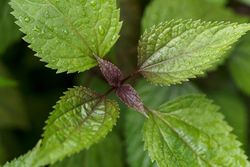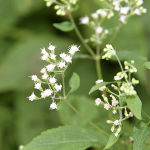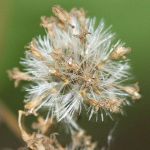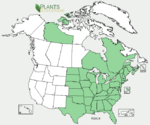White snakeroot
| White snakeroot |
|---|
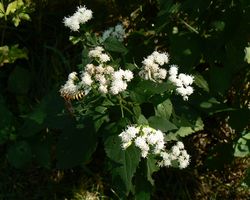
|
| Scientific Classification |
|
| Scientific Name |
|
Ageratina altissima |
| The leaves of a White Snakeroot |
The White Snakeroot is a species of snakeroot that is known by its scientific name Ageratina altissima. It is called snakeroot because of its ability to heal snake bites.[2] This plant is mostly notorious for its toxicity. The White Snakeroot has taken the lives of many people through its dangerous toxin, especially during the nineteenth century. Not only has this plant taken the lives of people, but also many animals that have consumed it.
Although this plant is a very harmful and deadly plant, it can be very useful to some people. White Snakeroots have pretty good medicinal uses, such as cures for snakebites. So even though this plant is very harmful to us, it can be quite useful in some ways.
To minimize the danger of this plant, you should take this plant out of the vicinity of other animals, as this would help minimize the death of animals, since it is dangerous for animals to consume. We all must stay aware, and be alert of our surroundings, as this plant could still be taking lives today. But as said before, even though it is a dangerous plant, it would be best to admire it from afar, because it is a beautiful plant after all.
Body Design
The White Snakeroot has large, seven inch long leaves that have toothed jagged edges.[3] The leaves seem to resemble an egg shape with a rounded base.[2] They are also oppositely arranged on the stems, with at least two leaves per node on the stem.[2] The leaves are simple leaves, and can grow up to at least fifty to one hundred and eighty millimeters long.[4]
The flowers of the White Snakeroot are gathered in dense white clusters at the end of the stem and branches.[3] The flowers have a name that distinguishes them from other flowers: disk flowers, which unlike other flowers, lacks a star shape.[4] If the flowers are looked at individually, they are small, white, and fuzzy due to the hair protrusions on it.[3] When mature, the flower heads can grow up to at least one half an inch wide, and each head is composed of up to ten to thirty flowers each.[2]
The seeds of the White Snakeroot are black in color.[3] Each seed has hairs on it, that can be dispersed by the wind.[3] In order for the seeds to germinate, the seed needs up to sixty days of cold stratification and light.[2]
Life Cycle
The first stage of the White Snakeroot the seed stage. In order for this plant to grow properly, the seeds must be planted in soil that is moisturized moderately.[2] The seeds also require full sun with at least partial shade to grow.[5] The time it takes for White Snakeroot plants to fully bloom would be between late summer to frost,[5] which would look to be between August to September.[3]
Once the White Snakeroot plant fully blooms, seeds are produced on the heads of the flowers. [6] As seen in the image on the left of this section, White Snakeroot seeds have little white hairs on them that can be dispersed by wind. This is how the seeds are transported from place to place.[3] Once the seeds are placed into good soil by wind dispersion, the process repeats. White Snakeroot plants are perennial, which means they can last up to two years![5]
The White Snakeroot can also reproduce by producing rhizomes, underground stems, once they have fully grown. When White Snakeroots have planted themselves with their rhizomes, they use vegetative growth (a growth phase in which the plant produces foliage) to be able to produce seeds. Once the seeds are produced, they will spread through the root system to places with suitable growth conditions.[2]
Ecology
The White Snakeroot plant is mostly native to woodland areas in Eastern North America.[5] The picture on the left shows White Snakeroot locations in North America.
White Snakeroots like to make their habitats on terrestrial terrain.[4] This plant usually grows at partially shaded areas in disturbed sites (examples include underneath fence rows and power lines). They also prefer to grow in areas such as woodland and path edges. White Snakeroot also requires full sunlight to grow as well, despite needing at least partial shade also.[5]
White Snakeroot is mostly consumed by cows, sheep, goats, and horses.[3] However, it is very dangerous if consumed by these animals, cows mostly. White Snakeroot contains a poisonous substance, called Tremetol. More information on the toxicity of the White Snakeroot can be found in the Toxicity section of this page.
Though White Snakeroot plants are toxic, they can be somewhat helpful to humans. For example, the White Snakeroot can also be used for folk medicine. It is used to treat fevers, diarrhea, and kidney stones. Poultices, which are pieces of material in the roots of plants, in the roots of White Snakeroot can be used to treat snakebites.[3]
Toxicity
As said before, the White Snakeroot contains a toxic substance called Tremetol. Tremetol is contained in the stems and leaves of a White Snakeroot.[3] If this plant is consumed by cows, the Tremetol in the stems and leaves will enter the milk the cows make when milked, and if cows consume enough White Snakeroot plants, they can become infected with a disease called "The Trembles", which can eventually lead to death.[2] White Snakeroot plants can be very deadly both dry and fresh, since Tremetol doesn't degrade during wilting of the plant.[3]
Even just a small amount of Tremetol in milk can be very dangerous for humans. If Tremetol-induced milk is consumed by humans, they have been infected by a disorder commonly known as Milk Sickness, or Tremetol Poisoning. Common signs of Milk Sickness include severe vomiting, constipation, and weakness, and can be fatal if not treated quickly. During the beginning of the nineteenth century, it is thought that Abraham Lincoln's mother tragically died due to the consumption of Tremetol-induced milk.[3]
Video
This video will tell you some facts about the White Snakeroot.
References
- ↑ Ageratina altissima (L.) R.M. King & H. Rob. white snakeroot United States Department of Agriculture. Web. Accessed on January 3, 2018. Unknown Author.
- ↑ 2.0 2.1 2.2 2.3 2.4 2.5 2.6 2.7 Bebeau, G.D.The Friends of the Wild Flower Garden, Inc. Plants of the Eloise Butler Wildflower Garden The oldest public wildflower garden in the United States Friends of the Wild Flower Garden. Web. Accessed on January 5, 2018.
- ↑ 3.00 3.01 3.02 3.03 3.04 3.05 3.06 3.07 3.08 3.09 3.10 3.11 White Snakeroot Facts SoftSchools.com. Web. Accessed on January 5, 2018. Unknown Author
- ↑ 4.0 4.1 4.2 Ageratina altissima (L.) King & H.E. Robins. White Snakeroot Go Botany. Web. Accessed on January 5, 2018. Unknown Author
- ↑ 5.0 5.1 5.2 5.3 5.4 Ageratina altissima Missouri Botanical Garden. Web. Accessed on January 9, 2018. Unknown Author.
- ↑ White Snakeroot Britannica.com. Web. Last Modified November 30, 2017. Unknown Author.
